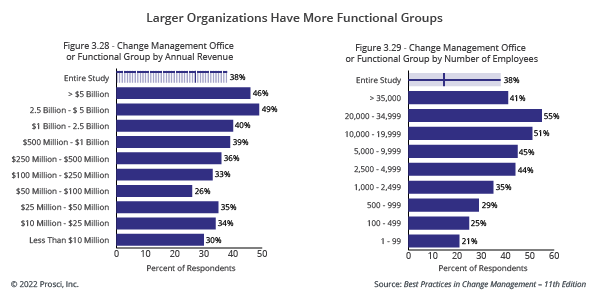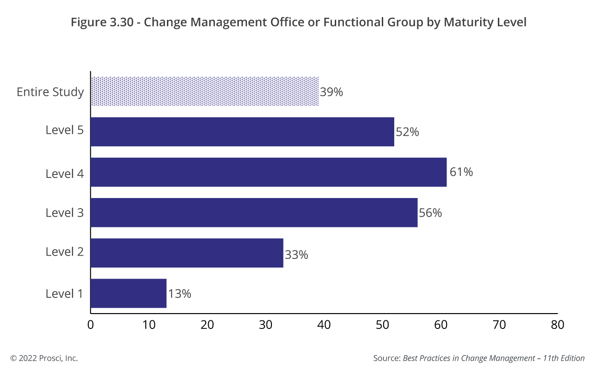The Change Management Office (CMO)

4 Mins
Updated: October 17, 2025
Published: October 13, 2022

Leading organizations are working to build enterprise change management capabilities to support their organizational agility and increase overall project success rates.
One of the steps taken when building this capability is to create a structure to support change management in the organization, usually in the form of a change management office (CMO), center of excellence (CoE), community of practice (CoP), or some other entity dedicated to change management.
This “organizational footprint” for change management can differ from organization to organization, varying in terms of size, location, composition and role. However, data and experience show that a functional group focused on change management provides value on the enterprise journey to build change management maturity.
Functionally, the group increases effectiveness and efficiency of change management by providing commonality and a single go-to point. The group also delivers value and creates credibility for the change management capability journey by demonstrating the commitment senior leaders have made in establishing this center.
Research insight: Prosci’s 2019 benchmarking study participants identified establishing CMOs and formalized internal roles as a top trend in the change management discipline over the the coming years.
This article offers a primer on the CMO or functional group. We'll explore the latest benchmarking data examining three crucial questions for practitioners and leaders looking to formulate and galvanize a change management structure in their organization.
CMO Trends From Prosci Research
For more than two decades, Prosci's benchmarking research has revealed the best practices and top trends in change management, resulting in the largest body of knowledge on change management in the discipline. Since 2013, Prosci has asked research participants about the CMOs and functional groups dedicated to change management in their organizations. A synopsis of the current state of the CMO/functional group follows.
Prevalence of CMOs
2019 participants reported a slight decrease in CMOs/functional groups dedicated to change management, with 38% of respondents reporting that their organizations had established one. Larger organizations were more likely to have a CMO/functional group. The top five industries that reported having a CMO or functional group were Education Services, Health Care, State Government, Other Government, and Food and Beverage. As expected, organizations with higher levels of change management maturity were more likely to have a CMO/functional group than those with lower maturity levels.

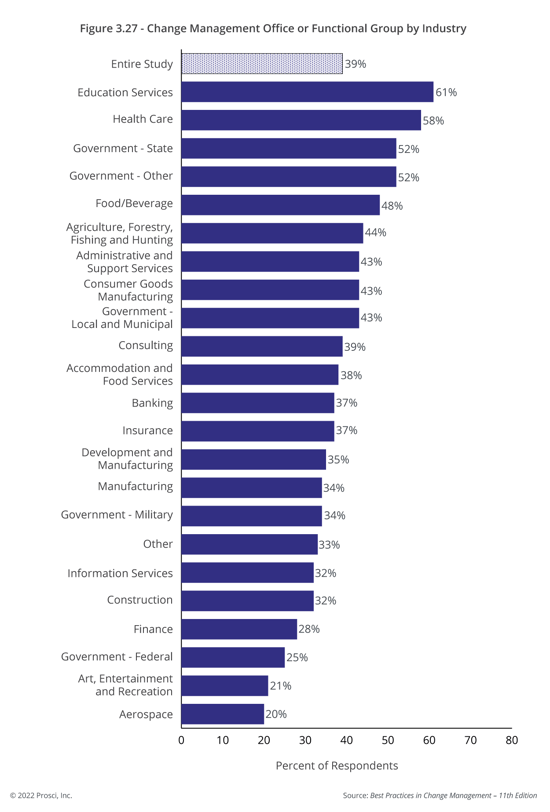
Size of CMOs
Most CMOs or change management functional groups were not all that big. Nearly half of the study participants reported CMOs/functional groups of between two and five employees. Just under one-fifth of respondents reported functional groups with more than ten employees. CMOs tend to be a small group of subject matter experts that support change management rather than a full bench of change practitioners, according to the research.
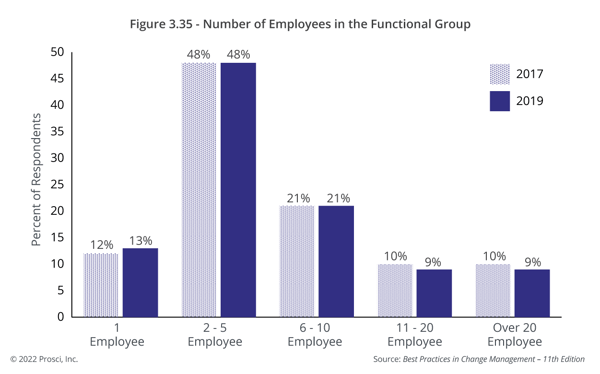
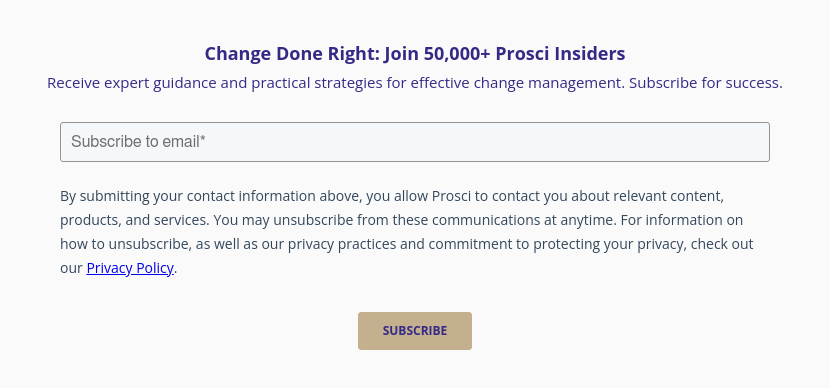
Names of CMOs
Study respondents also reported on the name of their CMO or functional group, including the commonly used names below.
A title using the words “change management,” including:
- Organizational Change Management
- Change Management Center of Excellence
- Enterprise Change Management
- Change Management Team
- Strategic Change Management
- Change Management Specialists
- People Change Management
- Change Management Division
- Change Management Network
A title using the word “change,” including:
- Change Practice
- Change Excellence
- Change Enablement
- Change and Culture Team
- Change Integration
- Change Hub
- Strategic Change Unit
- Change Specialists Group
Other titles used one of the following words related to change: transition, improvement, strategy, transformation, execution or excellence.
Building a CMO or Dedicated Change Management Functional Group
Prosci supports many innovative clients in building their organizational change management capability. While the goal is to bring a holistic perspective that includes various levers, the establishment of a structural change management group is quite common. Rather than prescribing a universal solution, we need to ask and answer three questions to build the best CMO:
- What should it do?
- How should it look?
- Where should it live?
1. What Should it Do?
What are the actual roles and responsibilities of the CMO? What is in scope and what is out of scope for the group? Too often, these questions are not answered. Everyone begins marching forward assuming they are all on the same page, when in reality they're far from it.
Participants in Prosci research share their insights on the role of the CMO below.
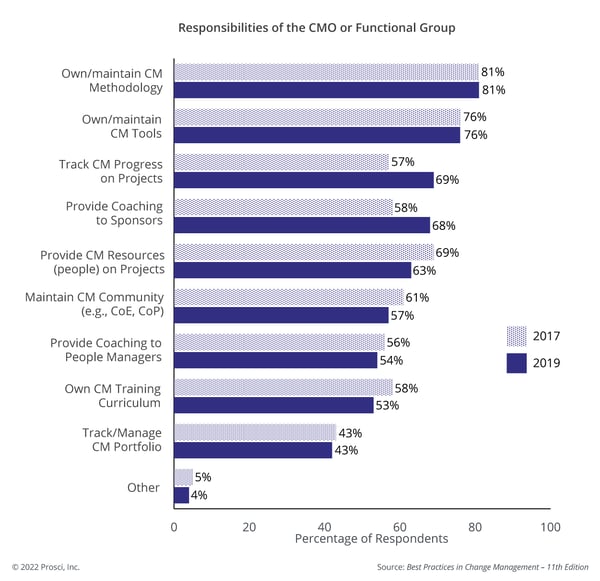
There is no single right answer for the roles and responsibilities of a CMO or functional group. Each industry, organization, functional group, and set of practitioners is unique, so it makes sense that each CMO or functional group will be unique in the contribution it makes to the organization. The key is ensuring that the roles and responsibilities are clearly defined and socialized. A sort of “charter” document for the CMO or functional group is a valuable asset for clearly articulating roles and responsibilities.
2. How Should it Look?
To centralize or not to centralize, that is the question. The design of the functional group matters. Some CMOs and functional groups are very centralized, others are completely decentralized, and still others fall on a hybrid spectrum somewhere in between.

As with roles and responsibilities, there is no single right answer. Whether you should centralize or decentralize depends—on the culture of the organization, geographic distribution of the organization, need for standardization/flexibility, and current level of variation in maturity.
Your choice also depends on where sponsorship and change management application resources (i.e., people) reside in the organization. And there are better and worse choices for CMO designs given your unique organization and the change management capability journey you're on.
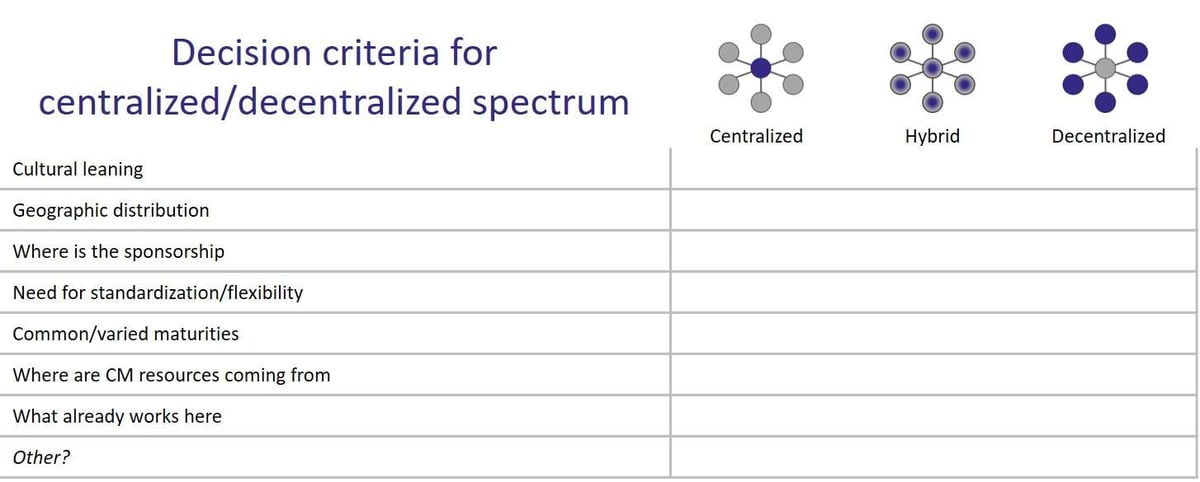
3. Where Should it Live?
One of the most common questions people ask is about where the the CMO or functional group should reside within the organization. And we address this question last here because answering the first two questions—about roles/responsibilities and centralized/decentralized structure—should ultimately inform your decision about the CMO's location.
Prosci’s 2019 benchmarking report includes data on both the current location of the CMO/functional group and the preferred location. The most common locations for the CMO were the project management office (PMO) and human resources. The most effective locations recommended by study participants were strategy, transformation and planning, or the PMO.
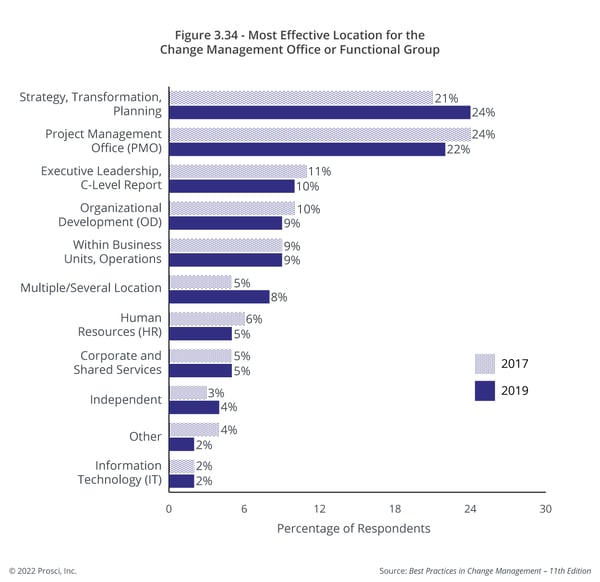
Once again, there is no single right answer for where the CMO belongs. It has been incredibly successful in a PMO and a complete failure in a PMO. It has been incredibly successful in HR and a complete failure in HR. While no universal “best” location exists, there are better or worse choices for your organization.
The decision criteria below emerged from Prosci research and our experience coaching organizations along their change capability journeys. Each factor may be a pro (+), neutral (O) or a con (-) for the various locations you're evaluating.
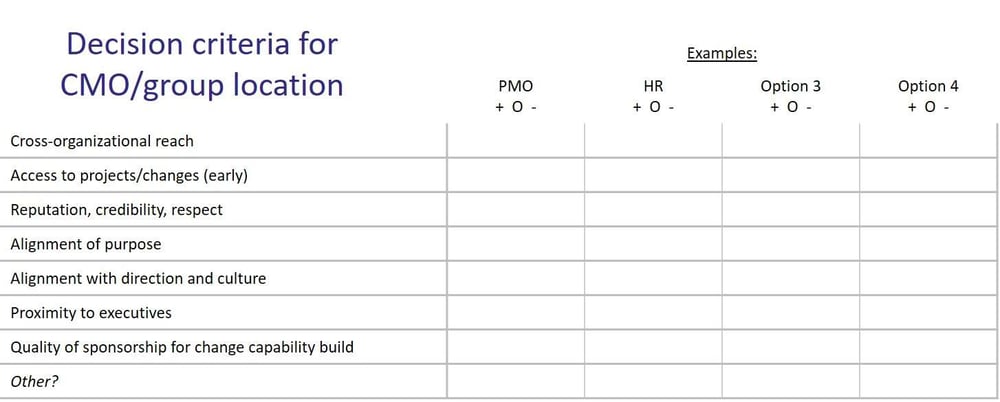
Grow Change Capability With a CMO
The winners of the future will be those who can out-change the competition while staying aligned with customer demands. Organizational agility will be key, and a developed change management capability is central to increasing agility. The establishment of a CMO or functional group serves to increase change management application, maturity and credibility. CMOs come in all shapes and sizes, but three key questions will help you develop yours most effectively: What should it do? How should it look? and and Where should it live?


